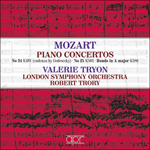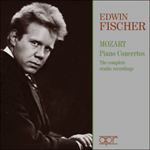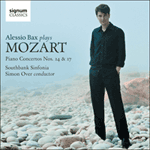
Welcome to Hyperion Records, a British classical label devoted to presenting high-quality recordings of music of all styles and from all periods from the twelfth century to the twenty-first.
Hyperion offers both CDs, and downloads in a number of formats. The site is also available in several languages.
Please use the dropdown buttons to set your preferred options, or use the checkbox to accept the defaults.

 PERFORMANCE
PERFORMANCE RECORDING
RECORDINGWhat makes this piece so different from Mozart’s other piano concertos? For one thing, the orchestra is large (this is the only Mozart piano concerto with both oboes and clarinets). For this piece Mozart used a rare type of paper ruled with sixteen staves. The autograph is in the collection of the Royal College of Music in London and is available in facsimile. It is nothing short of astonishing. In every way it reflects the unrest he must have felt at the time. His usual neatness has gone, and the autograph contains the earliest sketches right through to the final revisions, all rolled into one, with numerous crossings out and even funny little self-portraits to lead one to passages that got misplaced. Mozart wrote out the solo part (sometimes only abbreviated) after the rest and he ran out of space, having to write it in the staves for the trumpets and timpani. At one point in the slow movement, where the piano clashes with the winds, there is an obvious mistake.
The opening theme of the first movement uses all twelve tones of the scale. The time signature of 3/4 is uncommon (it’s also used in K449, but the feeling could not be more different). The rhythm of the chaconne, as Paul Badura-Skoda points out, is prominent. (There must be something linking C minor to unison writing. This concerto starts in unison as does Mozart’s C minor Piano Sonata, K457, the C minor Fantasy, K475, Beethoven’s Piano Concerto No 3, and the last movement of Beethoven’s Piano Sonata, Op 10 No 1.) In K491 the contours of the opening melody drag us downwards into despair. All of the themes Mozart uses in the first movement are somehow related to this opening material. They never escape it. Interestingly, though, the piano never openly states this main theme, but enters with its own lament (again using those wide leaps). The passage-work (not least in the remarkable coda) is all in a whirl, reflecting a feeling of hopelessness.
Mozart began the second movement but only wrote three bars before he changed his mind. It is interesting to see his first thoughts—a melody with more frills than the one he finally gave us. There is nowhere to hide in this drastically simple tune, first stated by the piano and then repeated like a chorus by the orchestra. When the piano continues its song, accompanied by the orchestra, a huge amount of emotion lies behind the apparently simple notes. The movement is in rondo form, and the episodes—the first in C minor, the second in A flat major—are given to the winds and then embellished by the piano and strings. A beautiful coda rounds off the movement.
Another rondo was out of the question, so instead Mozart turned to variation form for the finale. The tune could easily be completely gloomy if it wasn’t for the grace notes in the sixth and seventh bars. Most people see this as a march. I think it begins more like a sinister dance with its alla breve time signature. There’s still something of the Baroque in Mozart’s inspiration. The first two variations get increasingly busy, with whirling figures in the piano part. These come to the fore in the third variation (which is indeed march-like) in which the second violins have their moment. The change to A flat major in the fourth variation brings with it an abrupt change of mood. That part has always sounded to me as though some street musicians suddenly enter the scene, passing by the window, blissfully unaware of any tragic feelings. The fifth variation is amazing: beautiful counterpoint in the piano; then the scales in the left hand which we heard before in the second violins combine with the march-like rhythm in the right hand. C major enters for the sixth variation and tempts us into thinking the piece might end happily. It doesn’t. The original theme returns with interjections from the piano and winds. It builds up to a pause, and a brief cadenza. For the last variation, Mozart changes to 6/8—a time signature for the dance, if ever there was one. The piano begins, hesitatingly. The orchestra then joins in what becomes a whirling danse macabre, tormenting the soul until the very end.
from notes by Angela Hewitt © 2014
En quoi cette œuvre est-elle si différente des autres concertos pour piano mozartiens? D’abord, l’orchestre est imposant (c’est le seul concerto pour piano de Mozart avec et hautbois et clarinettes). Pour l’écrire, Mozart utilisa un type de papier rare, réglé à seize portées. L’autographe, qui appartient à la collection du Royal College of Music de Londres, est disponible en fac-similé. Il ne laisse pas d’étonner. On y lit partout la nervosité que Mozart dut ressentir en le rédigeant: il n’est pas soigné comme à l’ordinaire et renferme tout, des premières esquisses aux dernières révisions, avec quantité de biffures et même de drôles de petits autoportraits qui guident vers les passages mal placés. Mozart nota la partie solo (parfois seulement en abrégé) après la pause et, à court de place, dut se rabattre sur les portées des trompettes et des timbales. À un endroit du mouvement lent, là où le piano dissone avec les vents, il y a une erreur flagrante.
Le thème d’ouverture du premier mouvement utilise les douze tons de la gamme. Le signe de la mesure à 3/4 est rare (on le retrouve dans K449, mais l’impression ne saurait être plus différente). Le rythme de la chaconne est, pour rejoindre Paul Badura-Skoda, prégnant. (Il doit exister un lien entre ut mineur et l’écriture à l’unisson. Car c’est à l’unisson que ce concerto démarre, comme la Sonate pour piano en ut mineur, K457, et la Fantaisie et ut mineur, K475, sans oublier le Concerto pour piano nº 3 et le dernier mouvement de la Sonata pour piano, op.10 nº 1, de Beethoven.) Dans K491, les contours de la mélodie inaugurale nous plongent dans le désespoir. Tous les thèmes du premier mouvement sont, d’une manière ou d’une autre, affiliés à ce matériau liminaire. Aucun n’y échappe. Chose intéressante, pourtant, le piano n’énonce jamais ouvertement ce thème principal, mais entre avec sa propre lamentation (recourant, là encore, à de larges sauts). Le passage (ne serait-ce que dans la remarquable coda) n’est que tourbillon, signe de désespoir.
Mozart commença le deuxième mouvement mais il n’en avait pas écrit trois mesures qu’il se ravisa. Il est intéressant de regarder son premier jet—une mélodie plus enjolivée que la version finale. Il n’y a nulle part où se cacher dans cette mélodie d’une simplicité radicale, exposée au piano puis reprise, tel un chœur, par l’orchestre. Quand le piano poursuit son chant, escorté par l’orchestre, une immense émotion est tapie derrière les notes en apparence simples. Le mouvement est de forme rondo et les épisodes—le premier en ut mineur, le second en la bémol majeur—sont confiés aux vents avant d’être embellis par le piano et les cordes. Une splendide coda clôt le mouvement.
Un autre rondo étant exclu, Mozart se tourna, pour le finale, vers la forme variation. Sans les notes d’agrément des sixième et septième mesures, la musique pourrait facilement verser dans une totale noirceur. La plupart des gens y voient une marche. Pour moi, elle part davantage comme une danse sinistre, avec son signe de la mesure alla breve. Il reste quelque chose de baroque dans l’inspiration mozartienne. Les deux premières variations s’animent toujours plus, avec de tourbillonnantes figures pianistiques. Celles-ci sont au premier plan dans la troisième variation (dans le caractère d’une marche, de fait), où les seconds violons ont leur moment. Dans la quatrième variation, avec le passage au la bémol majeur, le climat change du tout au tout. Cette partie m’a toujours fait l’impression de musiciens de rue surgissant dans le décor, défilant à la fenêtre, dans la plus parfaite ignorance de tout sentiment tragique. La cinquième variation est stupéfiante: au piano, un merveilleux contrepoint; puis les gammes à la main gauche, qu’on entend d’abord aux seconds violons, amalgamées au rythme alla marcia à la main droite. Ut majeur fait son entrée pour la sixième variation et nous fait accroire que la pièce pourrait connaître une fin heureuse. Il n’en est rien. Le thème original revient, avec des interruptions au piano et aux vents. L’épisode prend corps jusqu’à une pause et une courte cadence. Pour la dernière variation, Mozart passe à 6/8—un signe de la mesure pour la danse, s’il en fut. Le piano part, hésitant. Puis l’orchestre le rejoint dans ce qui devient une tournoyante danse macabre, bourrelant l’âme jusqu’à la toute fin.
extrait des notes rédigées par Angela Hewitt © 2014
Français: Hypérion
Inwiefern unterscheidet sich dieses Werk so deutlich von Mozarts anderen Klavierkonzerten? Zum einen hat das Orchester eine große Besetzung (dies ist das einzige Klavierkonzert Mozarts mit sowohl Oboen als auch Klarinetten). Für dieses Werk verwendete Mozart ein seltenes Notenpapier mit 16 Notenzeilen. Das Autograph befindet sich in der Sammlung des Royal College of Music in London und ist als Faksimile erhältlich. Es ist absolut staunenswert. Es zeigt in verschiedenerlei Hinsicht die Unruhe, in der Mozart sich zu der Zeit befunden haben muss. Seine übliche Ordentlichkeit findet sich hier nicht und in dem Manuskript ist von seinen ersten Skizzen bis zu den letzten Überarbeitungen alles enthalten, so auch zahlreiche Streichungen und sogar komische kleine Selbstporträts, die zu Passagen führen, welche verlegt worden waren. Den Solopart notierte Mozart zuletzt (teilweise in abgekürzter Form) und hatte irgendwann keinen Platz mehr, so dass er ihn in die Notensysteme der Pauken und Trompeten eintrug. Im langsamen Satz findet sich an einer Stelle, wo das Klavier auf die Bläser trifft, sogar ein offensichtlicher Fehler.
Im Anfangsthema des ersten Satzes kommen alle zwölf Töne der Tonleiter zum Einsatz. Die Taktvorzeichnung 3/4 ist ungewöhnlich (sie kommt auch in KV 449 vor, doch könnte die Atmosphäre kaum unterschiedlicher sein). Der Chaconne-Rhythmus ist, wie Paul Badura-Skoda bemerkt, unverkennbar. (Die Tonart c-Moll muss eine Eigenschaft besitzen, die sie mit Unisono-Passagen in Verbindung bringt. Dieses Konzert beginnt im Unisono, und ebenso Mozarts Klaviersonate c-Moll, KV 457, die Fantasie c-Moll, KV 475, Beethovens Drittes Klavierkonzert und das Finale der Klaviersonate, op. 10, Nr. 1 von Beethoven.) In KV 491 wird der Hörer durch die Konturen der Anfangsmelodie in die Verzweiflung gezogen. Alle Themen, die Mozart im ersten Satz verwendet, sind in gewisser Weise mit diesem Anfangsmaterial verbunden. Sie kommen nie davon los. Interessanterweise legt das Klavier dieses Hauptthema jedoch nie offen dar, sondern setzt mit seinem eigenen Lamento ein (wiederum mit jenen weiten Sprüngen). Die virtuosen Passagen, nicht zuletzt in der bemerkenswerten Coda, erklingen wie in einem Wirbel und spiegeln ein Gefühl der Hoffnungslosigkeit wider.
Mozart begann den zweiten Satz, schrieb allerdings nur drei Takte, bevor er sich eines anderen besann. Es ist interessant, seine ersten Gedanken auf Papier zu sehen—eine ausgeschmücktere Melodie als diejenige, für die er sich schließlich entschied. Diese äußerst schlichte Melodie, die zuerst vom Klavier vorgetragen und dann vom Orchester, sozusagen als Chor, wiederholt wird, ist vollkommen offen und unverhüllt. Das Klavier fährt mit seinem Lied fort und wird dabei vom Orchester begleitet; hinter den scheinbar simplen Tönen liegen starke Emotionen. Der Satz ist in Rondo-Form angelegt und die Episoden—die erste in c-Moll, die zweite in As-Dur—sind den Bläsern anvertraut und werden dann vom Klavier und den Streichern ausgeschmückt. Eine wunderschöne Coda rundet den Satz ab.
Ein weiteres Rondo kam hier nicht in Frage, so dass Mozart das Finale in Variationenform anlegte. Das Thema könnte sehr niedergeschlagen wirken, wären da nicht die Vorhalte im sechsten und siebten Takt. Die meisten verstehen diese Musik als einen Marsch. Ich bin aber der Ansicht, dass sie eher, mit ihrer Taktvorzeichnung alla breve, wie ein unheilvoller Tanz beginnt. In Mozarts Inspiration finden sich durchaus noch barocke Elemente. Die ersten beiden Variationen werden zunehmend geschäftig und in der Klavierstimme erklingen umherwirbelnde Figuren. Diese treten in der dritten Variation hervor (die tatsächlich marschähnlich ist), wo die zweiten Geigen in den Vordergrund gerückt werden. Der Wechsel nach As-Dur in der vierten Variation bringt einen abrupten Stimmungswechsel mit sich. Diese Stelle klingt für mich immer so, als kämen plötzlich einige Straßenmusiker aufs Tapet und gingen in völliger Unwissenheit ob jeglicher Tragik am Fenster vorbei. Die fünfte Variation ist staunenswert: ein wunderschöner Kontrapunkt vom Klavier, dann die Tonleitern in der linken Hand, die zuvor in den zweiten Geigen zu hören waren, zusammen mit dem marschähnlichen Rhythmus in der rechten Hand. In der sechsten Variation tritt C-Dur auf und führt uns in Versuchung zu denken, dass das Werk ein glückliches Ende nehmen könnte. Das passiert aber nicht. Das ursprüngliche Thema kehrt mit Einwürfen vom Klavier und den Bläsern zurück. Es findet eine Steigerung statt und die Musik steuert auf eine Pause und Kadenz zu, die meiner Ansicht nach kurz gehalten werden sollte. In der letzten Variation wechselt Mozart zu 6/8—ein Tanzrhythmus, wie er im Buche steht. Das Klavier beginnt zögernd. Das Orchester gesellt sich dazu und die Musik entwickelt sich zu einem wirbelnden Totentanz, der die Seele bis zum äußersten Ende foltert.
aus dem Begleittext von Angela Hewitt © 2014
Deutsch: Viola Scheffel
 Mozart: Piano Concertos Nos 24 & 25 Mozart: Piano Concertos Nos 24 & 25'[A] simultaneously rich and discreet character in playing of an imperturbable clarity … a marvel of refined brilliance' (Gramophone)» More |
 Edwin Fischer - Mozart Piano Concertos Edwin Fischer - Mozart Piano Concertos‘A special contribution that Fischer made to the rehabilitation of Mozart was to revive the practice of performance directed from the keyboard. In thi ...» More |
 Mozart: Piano Concertos Nos 24 & 27 Mozart: Piano Concertos Nos 24 & 27Two of Mozart's best-loved concertos in performances from award-winning pianist Alessio Bax and the Southbank Sinfonia.» More |

